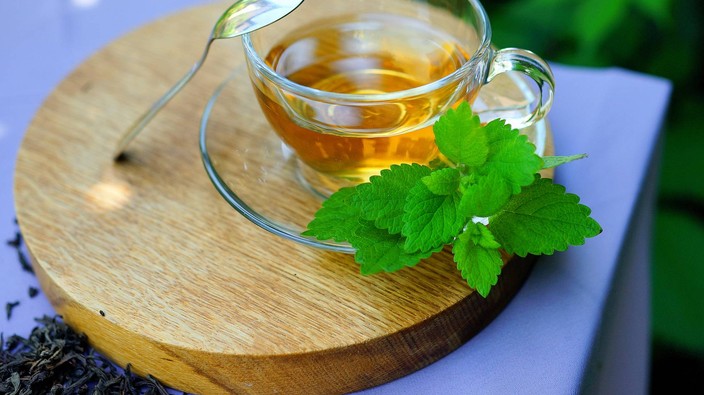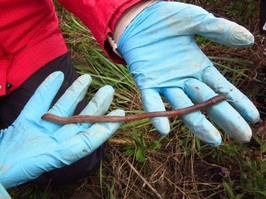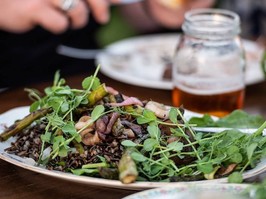how to grow your own cup of tea
from soothing chamomile to spicy ginger, many of our favourite teas can be grown right here in canada in your garden.

a fresh cup of mint tea can be enjoyed year-round.
getty
by mark & ben cullenwe think tea is the perfect gardener’s drink.while coffee powers us through the work week, taken to-go as we saddle up for a rush hour commute or fire up the computer for another assignment, tea reminds us to slow down. tea encourages contemplation and relaxation.we’re talking specifically about the non-caffeinated teas. why get your caffeine from tea when coffee is so good? maybe that’s just our opinion. in any event, many gardeners enjoy their herbal teas.for such an enriching beverage, the tea-aisle of any grocery store can leave lots to be desired. over-packaged, often in non-compostable tea bags and over-priced selections from unspecified origins and of unknown quality abound. yet for all the selection we often find ourselves reaching for the least-bad option. or whatever is on sale.thankfully, many of our favourite teas can be grown right here in canada in your garden. by growing your own, you aren’t just producing a superior product for yourself, you can add beauty to your garden and minimize your environmental footprint by eliminating packaging and “food-miles” from far off tea-producing countries.here are some of our favourite teas which you can produce for yourself this summer:echinacea
echinacea tea comes from one of our favourite perennial plants – known as purple coneflower or simply echinacea (echinacea purpurea). as a garden specimen, it’s hard to beat these plants for season-long colour and pollinator support. drought tolerant and hardy, we leave them standing through the winter for seasonal interest and to feed the birds.the purple flowers, leaves and roots all lend themselves to tea but we just use the flowers. if you do harvest the roots, clean them well before drying for tea production. leaves can be harvested any time and flowers after their second year of blooming. the best time to harvest the flowers is right before they fully open.to harvest by cutting the stem below the lowest set of leaves or just above the highest set of leaves if you only want the flower. discard the stem and spread the flowers and/or leaves on a drying rack in a warm, dry room. let them dry for 5-7 days until they are brittle, then store them in a sealed container in a cool, dark place until you are ready to steep. steep as you would any loose-leaf tea.chamomile
if you’re like ben and you find yourself wide awake in the middle of the night, chamomile tea might make an attractive sleep aid.german chamomile is the one you want if you’re planning on brewing it into tea. while it looks delicate, this is a tough plant that will be teeming with pollinators by the time it is in full bloom. it blooms abundantly, so you might as well leave some flowers for the bees.chamomile will grow in a range of soils and prefers full sun. direct-seeding chamomile is the easiest method of propagation either spring or fall. truth is, they self-propagate rather aggressively. it’s possible to start them indoors about 6-weeks before last frost if you want a head start on the growing season.like echinacea, the leaves and flowers both lend themselves to tea-making but given their delicate size, we tend to harvest only the flowers. it’s important to harvest before the flowers fully open, like echinacea, before pollen production, which will leave you with an itchy throat. we know because it’s happened to us.once you’ve slipped off your nearly opened flowers, dry them on a rack and store in a sealed container.mint
mint tea is universal. some people crave it when they’re sick, others enjoy it after dinner to soothe the belly. as a cooling tea, it’s one that we can enjoy right through the summer.growing mint is about as easy as growing dandelions (which can make a decent tea also). so easy, in fact, that it can take over your garden if you’re not careful. that’s why we tend to grow it in a container, or in a pot that is sunk into the ground. mint is one of the few tea plants that can tolerate a bit of shade.they are easy to start from a cutting or a rooted division of an existing plant, if you have a friend that is willing to share. otherwise, you can start it from seed and transplant when you plant out your vegetable garden in spring.constant harvesting will yield the best quality crop as the newest leaves have the most flavour. right before it flowers, cut the stem to one inch above the ground and you should be able to harvest a single plant two to three times in a single season. it is a bit like growing hay in this regard.ginger
ginger is not just a spicy and delicious tea, but it is also extremely versatile in the kitchen, especially if you cook a lot of asian dishes. ginger is like garlic in that it is very difficult to find locally produced crops, despite the fact it can be grown in most regions across canada and is so much more delicious when done so. however, we would not recommend garlic-tea.growing ginger is different from growing garlic as the part that is useful is a rhizome or fleshy root. to get started, use the ginger root that is in your fridge or purchased at a quality food store. find a rhizome with lots of growing nodes on it, much like planting seed potatoes, look for ‘eyes’. cut the root into pieces with each piece sporting a node or two.ginger takes about a year to produce and is not winter hardy in all but the most temperate growing zones in canada. grow in a container that you can bring inside for the winter. it should be at least one foot deep to accommodate root development. fill with well-drained and fertile potting mix and plant the rhizome just below the surface of the soil.water only minimally for the first few weeks to prevent the root rotting. when the shoots start to emerge, apply water more thoroughly and mist periodically to maintain humidity. ginger requires warmth and full sunlight.after about a year, your plant will be ready for harvest. this is something you can harvest continually once the plant is mature, so only cut the amount of root that you need. the newer growth is the most flavourful. cut the stems from the roots and store in the fridge for up to three weeks.cook with ginger according to your recipe or cut it into small cubes and brew like any loose-leaf tea.growing your own tea can be fun, satisfying and money-saving.
echinacea tea comes from one of our favourite perennial plants – known as purple coneflower or simply echinacea (echinacea purpurea). as a garden specimen, it’s hard to beat these plants for season-long colour and pollinator support. drought tolerant and hardy, we leave them standing through the winter for seasonal interest and to feed the birds.the purple flowers, leaves and roots all lend themselves to tea but we just use the flowers. if you do harvest the roots, clean them well before drying for tea production. leaves can be harvested any time and flowers after their second year of blooming. the best time to harvest the flowers is right before they fully open.to harvest by cutting the stem below the lowest set of leaves or just above the highest set of leaves if you only want the flower. discard the stem and spread the flowers and/or leaves on a drying rack in a warm, dry room. let them dry for 5-7 days until they are brittle, then store them in a sealed container in a cool, dark place until you are ready to steep. steep as you would any loose-leaf tea.chamomile
if you’re like ben and you find yourself wide awake in the middle of the night, chamomile tea might make an attractive sleep aid.german chamomile is the one you want if you’re planning on brewing it into tea. while it looks delicate, this is a tough plant that will be teeming with pollinators by the time it is in full bloom. it blooms abundantly, so you might as well leave some flowers for the bees.chamomile will grow in a range of soils and prefers full sun. direct-seeding chamomile is the easiest method of propagation either spring or fall. truth is, they self-propagate rather aggressively. it’s possible to start them indoors about 6-weeks before last frost if you want a head start on the growing season.like echinacea, the leaves and flowers both lend themselves to tea-making but given their delicate size, we tend to harvest only the flowers. it’s important to harvest before the flowers fully open, like echinacea, before pollen production, which will leave you with an itchy throat. we know because it’s happened to us.once you’ve slipped off your nearly opened flowers, dry them on a rack and store in a sealed container.mint
mint tea is universal. some people crave it when they’re sick, others enjoy it after dinner to soothe the belly. as a cooling tea, it’s one that we can enjoy right through the summer.growing mint is about as easy as growing dandelions (which can make a decent tea also). so easy, in fact, that it can take over your garden if you’re not careful. that’s why we tend to grow it in a container, or in a pot that is sunk into the ground. mint is one of the few tea plants that can tolerate a bit of shade.they are easy to start from a cutting or a rooted division of an existing plant, if you have a friend that is willing to share. otherwise, you can start it from seed and transplant when you plant out your vegetable garden in spring.constant harvesting will yield the best quality crop as the newest leaves have the most flavour. right before it flowers, cut the stem to one inch above the ground and you should be able to harvest a single plant two to three times in a single season. it is a bit like growing hay in this regard.ginger
ginger is not just a spicy and delicious tea, but it is also extremely versatile in the kitchen, especially if you cook a lot of asian dishes. ginger is like garlic in that it is very difficult to find locally produced crops, despite the fact it can be grown in most regions across canada and is so much more delicious when done so. however, we would not recommend garlic-tea.growing ginger is different from growing garlic as the part that is useful is a rhizome or fleshy root. to get started, use the ginger root that is in your fridge or purchased at a quality food store. find a rhizome with lots of growing nodes on it, much like planting seed potatoes, look for ‘eyes’. cut the root into pieces with each piece sporting a node or two.ginger takes about a year to produce and is not winter hardy in all but the most temperate growing zones in canada. grow in a container that you can bring inside for the winter. it should be at least one foot deep to accommodate root development. fill with well-drained and fertile potting mix and plant the rhizome just below the surface of the soil.water only minimally for the first few weeks to prevent the root rotting. when the shoots start to emerge, apply water more thoroughly and mist periodically to maintain humidity. ginger requires warmth and full sunlight.after about a year, your plant will be ready for harvest. this is something you can harvest continually once the plant is mature, so only cut the amount of root that you need. the newer growth is the most flavourful. cut the stems from the roots and store in the fridge for up to three weeks.cook with ginger according to your recipe or cut it into small cubes and brew like any loose-leaf tea.growing your own tea can be fun, satisfying and money-saving.
mark cullen is an expert gardener, author, broadcaster and tree advocate and holds the order of canada. his son, ben, is a fourth-generation urban gardener and a graduate of the university of guelph and dalhousie university in halifax.
follow them at markcullen.com, @markcullen4, facebook.com/markcullengardening and biweekly on global tv’s national morning show, the morning show.
this story previously appeared in harrowsmith magazine. published by moongate publishing inc., harrowsmith provides a purely canadian take on country living, the environment, and the sharing of useful information for country dwellers and city folk.
 5 minute read
5 minute read





